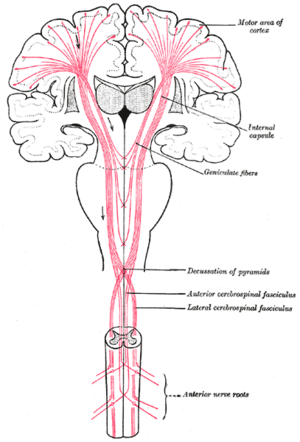Upper motor neuron lesion
| Upper motor neuron lesion | |
|---|---|
 | |
| The motor tract. | |
| Classification and external resources | |
| DiseasesDB | 27852 |
An upper motor neuron lesion (also known as pyramidal insufficiency) occurs in the neural pathway above the anterior horn cell of the spinal cord or motor nuclei of the cranial nerves. Conversely, a lower motor neuron lesion affects nerve fibers traveling from the anterior horn of the spinal cord or the cranial motor nuclei to the relevant muscle(s).[1]
Upper motor neuron lesions occur in the brain or the spinal cord as the result of stroke, multiple sclerosis, traumatic brain injury and cerebral palsy.
Symptoms
Changes in muscle performance can be broadly described as the upper motor neuron syndrome. These changes vary depending on the site and the extent of the lesion, and may include:
- Muscle weakness. A pattern of weakness in the extensors (upper limbs) or flexors (lower limbs),[2] is known as 'pyramidal weakness'
- Decreased control of active movement, particularly slowness
- Spasticity, a velocity-dependent change in muscle tone
- Clasp-knife response where initial higher resistance to movement is followed by a lesser resistance
- Babinski sign is present, where the big toe is raised (extended) rather than curled downwards (flexed) upon appropriate stimulation of the sole of the foot. The presence of the Babinski sign is an abnormal response in adulthood. Normally, during the plantar reflex, it causes plantar flexion and the adduction of the toes. In Babinski's sign, there is dorsiflexion of the big toe and abduction of the other toes. Physiologically, it is normally present in infants from birth to 12 months. The presence of the Babinski sign after 12 months is the sign of a non-specific upper motor neuron lesion.
- Increased deep tendon reflex (DTR)
- Pronator drift [3]
Corticospinal/pyramidal tract
These are the neural tracts which descend in the ventral horn of the spinal cord, carrying signals for voluntary movement of skeletal muscle. These nerve fibers usually originate in the primary motor cortex, pass via the corona radiata to gather in the internal capsule before crossing over to the opposite side (decussation) in the medullary pyramids and proceeding down the spinal cord to meet lower motor neurons in the anterior grey column.
See also
References
- ↑ James D. Fix (1 October 2007). Neuroanatomy. Lippincott Williams & Wilkins. pp. 120–. ISBN 978-0-7817-7245-7. Retrieved 17 November 2010.
- ↑ "upper motor neurone signs"
 . GPnotebook.
. GPnotebook. - ↑ "The Precise Neurological Exam". Retrieved 2009-11-28.
External links
- http://www.med.yale.edu/caim/cnerves/cn7/cn7_13.html
- http://www.lib.mcg.edu/edu/eshuphysio/program/section8/8ch3/s8ch3_34.htm